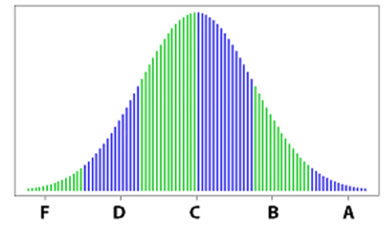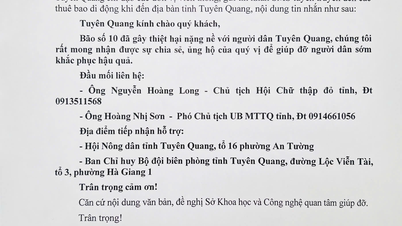The "bell curve" (or "grading curve") grading method is attracting a lot of attention, especially in education today. In Vietnam, in my opinion, this assessment method can help reflect students' abilities more accurately. However, it needs to be applied flexibly and appropriately to the actual context.
The bell curve, also known as a "bell curve," is a bell-shaped graph that represents a normal distribution. It shows that most values are concentrated in the middle, with a few values falling on either end (i.e., too high or too low). For example, in a class, most students will have average or good grades, while only a few will have very high or very low grades.

The bell curve represents the normal distribution.
One of the key benefits of this assessment method is the ability to control “grade inflation”, which is becoming a growing concern in Vietnam. Currently, many graduation classes have more than half of the students achieving good grades, which reduces the value of the degree and makes students not need to work hard to achieve high results. When the scores are all high, it is difficult to distinguish who is truly capable and who is just favored by the lenient grading system.
Currently, universities in Vietnam are applying a 10-point scale for exams and subject averages, which are then directly converted into ABCD grades based on fixed scores. For example, if a student scores from 8.5 to 10 points, he will be ranked A, from 7 to 8.4 will be B, from 5.5 to 6.9 is C; and from 4 and above will be considered as passing with D.
This method is simple, easy to understand, and helps students clearly understand the classification standards. However, it can easily cause score inflation when too many students achieve high scores that do not reflect their true abilities. On the contrary, in the fields of art, painting, literature, architecture, etc., students often only receive average scores, rarely high scores or absolute high scores. This invisibly creates a disadvantage in comparison and evaluation between art schools.
The bell curve system does not base grades on a fixed number of points, but on a normal distribution of grades in the class. After students receive their grades on a 10 or 100-point scale, the instructor adjusts based on the relative distribution of the entire class. Only a small fraction, about 10-20%, are given an A, followed by a B, and the majority of students fall into the C and D ranges. This method helps prevent grade inflation by limiting the number of students who receive high grades, ensuring that the differences in ability between students are accurately reflected.
For example, in a class of 100 students, if grading is on a 10-point scale, an exam that is too easy might result in an A for the entire class, or if it is too difficult, the entire class might only get a C or D. With the bell curve method, even if the exam is difficult and the average score is 5/10, the class will still have about 10 students getting A, 40 students getting B, 40 students getting C, and 10 students getting D. This helps distribute grades more fairly and accurately reflects students' abilities.
Another benefit of the bell curve is its flexibility and objectivity. In traditional assessment methods, instructors grade based on fixed standards, which sometimes do not reflect the differences between classes, subjects, or universities. With the bell curve, students' scores are compared with those of their classmates, providing a more comprehensive and fair assessment of each individual's true ability, instead of relying solely on a rigid 10-point scale to convert letter grades.

The "Bell curve" allows employers to more accurately assess candidates' abilities when recruiting (Illustration: CV)
As I mentioned above, the "bell curve" only applies in the transition period between numerical scores and letter grades, and there is absolutely no difference or impact on teaching, grading, and student assessment as before, or on universities having to struggle to find every measure to "tighten" output standards.
Some university training programs such as RMIT University Vietnam have also applied the "bell curve" assessment system to ensure that students' scores are assessed fairly and in line with world standards.
During my time studying at Stanford (USA), after each test, the 100-point scale score and the class average score along with the distribution chart of the score spectrum were clearly announced to the whole class by the lecturer after each test.
The “bell curve” also allows employers to more accurately assess candidates’ abilities when recruiting. When scores are no longer inflated, degrees become more valuable and reflect the true abilities of learners. This helps businesses select truly capable candidates, thereby improving the quality of human resources.
However, this is not a perfect method. The "bell curve" itself creates competitive pressures and unfairness. A student may get a high score, say an 8/10, but if the other students in the class also get high scores, they may still get a C.
This can be unfair in classes that already have many good students such as gifted classes. In addition, in classes with few students or classes with no big difference in ability, the "bell curve" may not be effective and may lead to bias in assessment. Therefore, the application of the "bell curve" and the choice of the score distribution ratio also requires flexibility from teachers and education managers.
Applying assessment methods such as the bell curve is one of the effective solutions to control and minimize grade inflation. However, this needs to be done carefully and in accordance with the actual conditions of each school and each field of study.
Ultimately, it is education about the meaning of grades and the true value of knowledge that is most important. Grades are not the ultimate goal of learning, but only a means to measure the entire learning process.
Author: Trinh Phuong Quan (Architect) graduated with a master's degree in civil and environmental engineering from Stanford University (USA). Before that, Quan studied sustainable design at the National University of Singapore and the Ho Chi Minh City University of Architecture. Quan participates in architectural design, planning, and is also a contributor to many newspapers, focusing on topics related to the environment, design, and culture.
The FOCUS column hopes to receive readers' comments on the content of the article. Please go to the Comments section and share your thoughts. Thank you!
Source: https://dantri.com.vn/tam-diem/qua-nhieu-sinh-vien-kha-gioi-nen-thay-doi-cach-danh-gia-thang-diem-20241009214737040.htm





![[Photo] Binh Trieu 1 Bridge has been completed, raised by 1.1m, and will open to traffic at the end of November.](https://vphoto.vietnam.vn/thumb/1200x675/vietnam/resource/IMAGE/2025/10/2/a6549e2a3b5848a1ba76a1ded6141fae)































































































Comment (0)